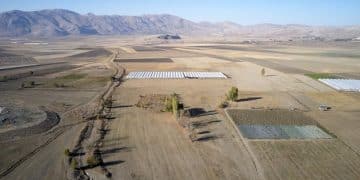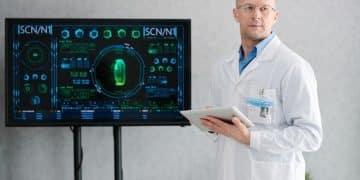Robotics and Automation: Latest US Manufacturing and Logistics Advancements
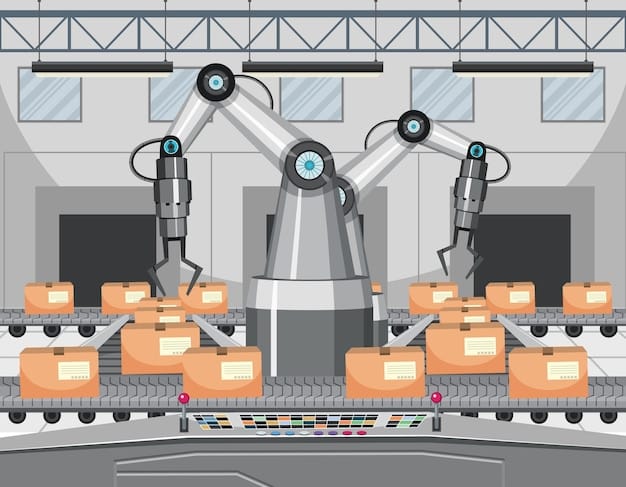
Robotics and automation are transforming manufacturing and logistics in the US, with recent advancements including AI-powered robots, collaborative robots (cobots), and advanced logistics automation systems enhancing efficiency, precision, and safety.
The integration of robotics and automation in the manufacturing and logistics sectors across the US marks a pivotal shift towards enhanced efficiency, precision, and adaptability. This transformation is driven by the need to optimize operations, reduce costs, and meet the increasing demands of a global marketplace, making it essential to understand the latest advancements in this field.
The Rise of Robotics in US Manufacturing
Robotics has become an integral part of US manufacturing, revolutionizing how products are made and processes are managed. The adoption of robotic systems is driven by their ability to perform repetitive tasks with high accuracy, increase production speed, and improve overall safety within manufacturing environments.
Benefits of Robotics in Manufacturing
Robotics offers numerous benefits, leading to increased efficiency, reduced costs, and improved quality in manufacturing processes. These advantages make robotic integration a key strategy for companies looking to stay competitive.
- Increased Productivity: Robots can operate 24/7 without breaks, significantly increasing production output.
- Enhanced Precision: Robotic systems ensure consistent quality and accuracy, reducing defects and waste.
- Improved Safety: Robots can handle dangerous tasks, minimizing risks to human workers.
The integration of robotics is not just about replacing human labor, but also about augmenting it. By automating routine tasks, human workers can focus on more complex and value-added activities, fostering a more skilled and productive workforce.
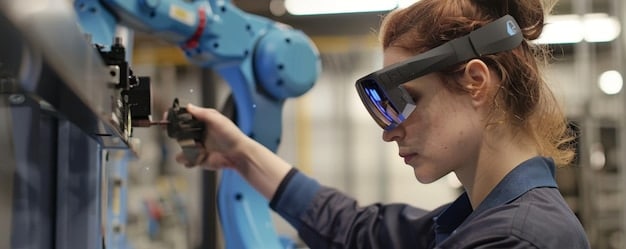
Automation in Logistics: Streamlining the Supply Chain
Automation is transforming the logistics industry in the US, streamlining the supply chain from warehousing to transportation. Advanced automation systems are optimizing processes, reducing errors, and speeding up delivery times, ultimately enhancing customer satisfaction.
Logistics automation encompasses a wide range of technologies, including automated guided vehicles (AGVs), automated storage and retrieval systems (AS/RS), and advanced sorting and picking systems. These technologies work together to create a more efficient and resilient supply chain.
Key Technologies in Logistics Automation
Several key technologies are driving the automation of logistics, each contributing to improved efficiency and precision in the supply chain.
- Automated Guided Vehicles (AGVs): AGVs transport materials within warehouses and distribution centers without human intervention.
- Automated Storage and Retrieval Systems (AS/RS): AS/RS automate the storage and retrieval of goods, maximizing space utilization and reducing retrieval times.
- Sorting and Picking Systems: Advanced sorting and picking systems use sensors and AI to accurately sort and pick items, speeding up order fulfillment.
By automating these processes, logistics companies can reduce labor costs, minimize errors, and improve delivery times, enhancing their competitiveness in the market. Automation also enables better tracking and management of inventory, reducing the risk of stockouts and overstocking.
Artificial Intelligence (AI) Integration in Robotics and Automation
Artificial intelligence (AI) is playing an increasingly important role in both robotics and automation, enhancing the capabilities of these systems and enabling them to perform more complex tasks. AI-powered robots can adapt to changing environments, learn from experience, and make autonomous decisions, leading to more efficient and flexible operations.
AI is also used in predictive maintenance, where algorithms analyze data from sensors to predict when a machine is likely to fail. This allows companies to perform maintenance proactively, minimizing downtime and reducing the risk of costly breakdowns, while improving safety by preventing unexpected equipment failures.
How AI Enhances Robotic Systems
AI enhances robotic systems in several key ways, improving their performance and enabling them to tackle more complex tasks.
- Machine Learning: Robots can learn from data and improve their performance over time, adapting to changing conditions.
- Computer Vision: AI-powered computer vision enables robots to “see” and interpret their surroundings, allowing them to navigate complex environments and identify objects.
- Natural Language Processing (NLP): NLP allows robots to understand and respond to human language, facilitating better communication and collaboration.
The integration of AI is not just about making robots smarter; it’s about creating systems that can continuously improve and adapt to changing conditions, leading to greater efficiency and resilience in manufacturing and logistics.
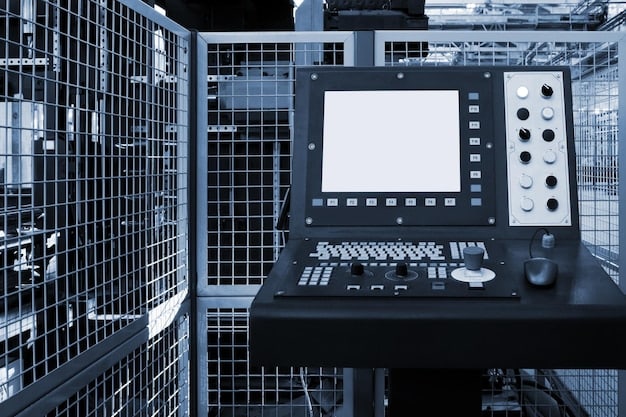
Collaborative Robots (Cobots): Working Alongside Humans
Collaborative robots, or cobots, are designed to work alongside human workers, enhancing productivity and improving safety. Unlike traditional industrial robots, cobots are equipped with sensors and safety features that allow them to operate in close proximity to humans without posing a risk. These sensors also help improve the maintenance schedule.
Cobots are increasingly being used in a variety of manufacturing and logistics applications, including assembly, packaging, and material handling. Their ability to work safely and efficiently alongside humans makes them a valuable asset in today’s workplaces.
Cobots are not meant to replace human workers entirely but work together so the company has the best of both worlds. Cobots can be particularly useful in relieving human workers that might be getting burnt out or tired from repeated tasks, which can improve both output and happiness among workers in a company.
The Impact of Robotics and Automation on Employment in the US
The increasing adoption of robotics and automation in US manufacturing and logistics has raised concerns about its potential impact on employment. While some jobs may be displaced by automation, new opportunities are also being created in areas such as robot design, programming, and maintenance. Companies also need people to repair these machines, which opens the door for many more jobs in the field. In some cases the maintenance staff can even be paid higher than the manufacturing staff on the floor.
It is important to understand that the implementation of robotics and automation is not just about replacing human labor; it’s about transforming the nature of work. By automating routine tasks, businesses can focus more on what is helpful in the current marketplace, which can create a better workplace for everyone.
Addressing Employment Concerns
To mitigate the impact of automation on employment, businesses and policymakers are taking steps to ensure that workers have the skills they need to succeed in the changing job market.
- Investing in Education and Training: Providing workers with opportunities to learn new skills, such as robot programming and maintenance, helps them transition to new roles.
- Promoting Lifelong Learning: Encouraging workers to continuously update their skills throughout their careers ensures they remain relevant in the workforce.
- Supporting Entrepreneurship: Creating a supportive environment for entrepreneurs can lead to the creation of new businesses and jobs in emerging industries.
By investing in education and training, promoting lifelong learning, and supporting entrepreneurship, the US can ensure that its workforce is prepared for the challenges and opportunities presented by robotics and automation.
Future Trends in Robotics and Automation
The future of robotics and automation in US manufacturing and logistics is expected to be marked by even greater integration of AI, increased adoption of collaborative robots, and the development of more flexible and adaptable systems. As technology continues to evolve, robots and automation systems will become even more capable and versatile, transforming the way goods are made and delivered.
One of the key trends is the development of more advanced AI algorithms that can enable robots to perform more complex tasks with greater autonomy. This will lead to the creation of robots that can adapt to changing conditions in real-time, making them more suitable for a wider range of applications.
Emerging Technologies
Several emerging technologies are expected to play a significant role in the future of robotics and automation.
- 5G Connectivity: 5G networks will enable faster and more reliable communication between robots and other systems, facilitating real-time data analysis and control.
- Digital Twins: Digital twins are virtual models of physical systems that can be used to simulate and optimize performance. They can even give users an idea of when a machine or system might fail so that maintenance can be performed before it ever happens.
- Edge Computing: Edge computing brings data processing closer to the source, reducing latency and enabling faster decision-making.
These emerging technologies will enable the creation of more sophisticated and interconnected robotic and automation systems, paving the way for a new era of manufacturing and logistics.
| Key Point | Brief Description |
|---|---|
| 🤖 AI-Powered Robots | Enhance adaptability and decision-making in manufacturing. |
| 🤝 Collaborative Robots | Improve safety and productivity by working alongside humans. |
| 🚚 Logistics Automation | Streamlines supply chains, reducing errors and delivery times. |
| 📈 Predictive Maintenance | Uses AI to predict equipment failures, reducing downtime and costs. |
FAQ
▼
Robots in manufacturing enhance productivity by operating continuously, improve precision, reducing defects, and increase safety by handling dangerous tasks.
▼
Automation in logistics streamlines the supply chain using AGVs, AS/RS, and advanced sorting systems, speeding up delivery times and reducing errors.
▼
AI enables robots to adapt to changing environments, learn from experience, and make autonomous decisions, leading to more efficient and reliable operations.
▼
Cobots are designed to work safely alongside humans, equipped with sensors that can prevent injuries. Cobots can improve collaborative teamwork in facilities, improving production output.
▼
Companies and policymakers can invest in education and training, support lifelong learning, and promote entrepreneurship to ensure workers have the skills for new jobs. It’s important to remember that robots also require maintenance.
Conclusion
The advancements in robotics and automation are revolutionizing US manufacturing and logistics, driving efficiency, precision, and safety. As these technologies continue to evolve, it is crucial for businesses and policymakers to adapt and embrace the changing landscape to remain competitive and ensure a skilled workforce.
